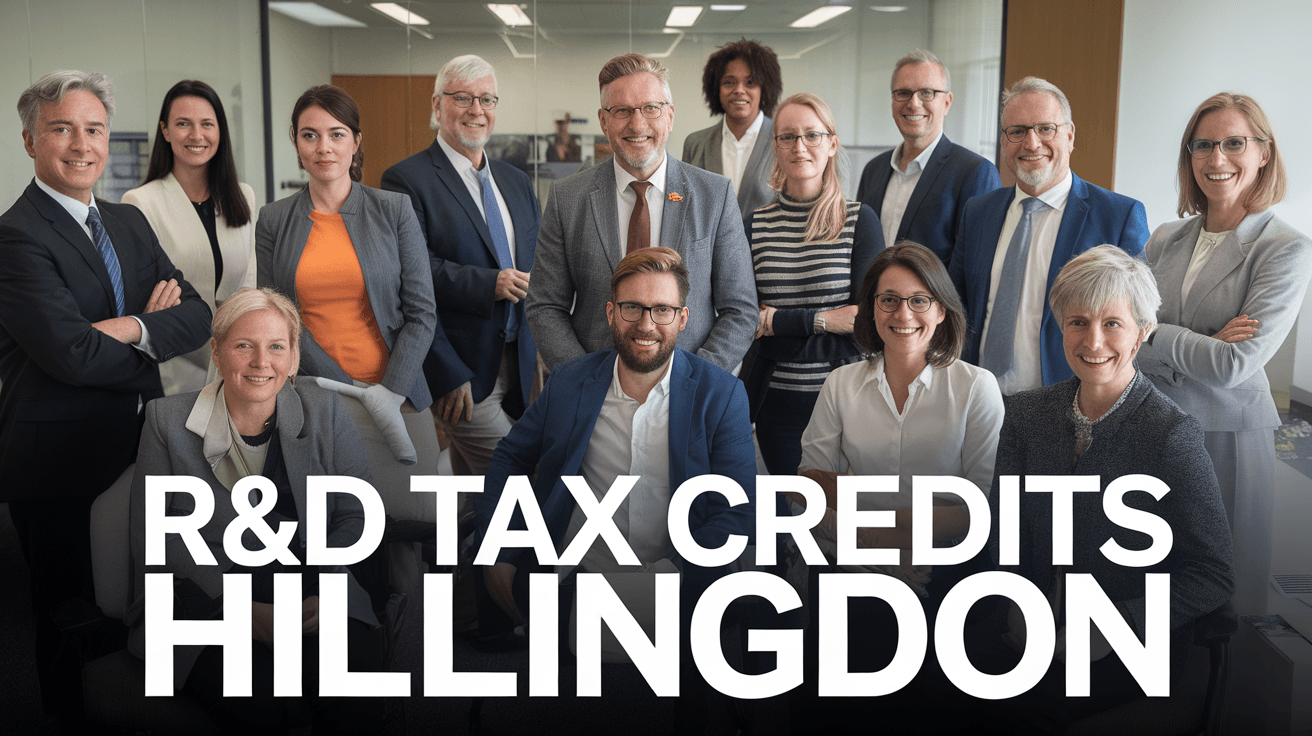R&D Tax Credits Hillingdon Greater London
R&D Tax Credits are a financial incentive offered by the UK Government to businesses in Hillingdon and across Greater London, aimed at fostering innovation and investment in research and development. These credits can significantly reduce your corporation tax liability or provide a cash payment if your company is loss-making.
Only limited companies and partnerships that are liable for corporation tax can apply for these credits. The projects must involve scientific or technological uncertainty and aim to resolve it through new or improved processes, materials, devices, or products. Both SMEs and large companies are eligible, with differing rates and rules.
R&D Tax Credits can help you invest in innovation and drive growth in the local economy. R&D Tax Credit Specialists can assist you in navigating the complex regulations, identifying all eligible activities, and maximising your financial relief, ensuring you focus on your core business while they handle the tax process.

How Do R&D Tax Credits Benefit Hillingdon Businesses?
R&D tax credits provide financial incentives to Hillingdon businesses, encouraging innovation and growth. These credits reduce tax liabilities or generate cash refunds, making it easier for you to invest in new technologies and processes.
Financial Advantages
R&D tax credits offer significant financial relief to Hillingdon businesses, allowing you to reclaim a portion of the expenses incurred during research and development activities. This financial support can be used to fund further innovation, hire skilled personnel, or upgrade equipment, all of which are crucial for staying competitive in the market.
Competitive Edge in Innovation
By leveraging R&D tax credits, you can gain a competitive edge in your industry. The additional funds enable you to invest in cutting-edge research, develop new products, and enhance existing ones. This not only helps you stand out from competitors but also positions your business as a leader in innovation, attracting more customers and partnerships.

Which Industries Commonly Claim R&D Tax Credits?
Technology Sector, manufacturing, life sciences, and other sectors frequently claim R&D tax credits in the UK. These industries often invest heavily in innovative projects and can benefit significantly from the tax relief.
Technology Sector
The technology sector is a key player in R&D tax credit claims. Companies in this industry focus on developing new software, hardware, and digital solutions. This sector's investment in innovation is crucial for staying competitive in a rapidly evolving market.
Manufacturing
Manufacturing firms are another significant group claiming R&D tax credits. These companies often invest in new production techniques, materials, and machinery to improve efficiency and product quality. The credits can help offset the costs of these advancements, making the sector more robust and innovative.
Life Sciences
The life sciences industry, including pharmaceuticals and biotechnology, is also a major beneficiary of R&D tax credits. These companies invest heavily in research to develop new treatments, drugs, and medical technologies. The credits support the high costs associated with clinical trials and regulatory approvals.
Others
Other industries, such as construction, automotive, and energy, also claim R&D tax credits. These sectors often engage in innovative projects that can lead to more sustainable and efficient practices. The credits can provide a financial boost to support these initiatives.

What Qualifies as R&D Under UK Tax Law?
R&D qualifies under UK tax law if it involves resolving scientific or technological uncertainties to achieve an advance in the field. The process must involve systematic investigation or experimentation.
Qualifying Activities
Activities such as developing new or improved products, processes, or services can qualify as R&D. This includes software development, engineering, and scientific research.
Excluded Activities
Excluded activities include market research, management studies, and the production of commercial prototypes. These do not involve resolving scientific or technological uncertainties.
Understanding what qualifies as R&D is crucial for claiming tax relief effectively.

R&D Tax Credits are calculated based on the eligible costs you incur in the process of researching and developing new products, processes, or services. The formula for calculation varies depending on whether your company qualifies under the SME Scheme or the RDEC Scheme.
SME Scheme
For the SME Scheme, you can claim a percentage of your qualifying R&D costs. If your company has fewer than 500 employees and an annual turnover or balance sheet total of less than €100 million, you are likely eligible. The credit is calculated as 130% of your qualifying R&D costs, which can be offset against your corporation tax liability. This means for every £1 of qualifying R&D expenditure, you can claim an additional £1.30 to reduce your tax bill.
RDEC Scheme
The RDEC Scheme is designed for larger companies or those that are not eligible for the SME Scheme. Under this scheme, you receive a payable tax credit of 13% on your qualifying R&D costs. This credit is paid directly to your company, providing a financial boost to support your R&D activities. The RDEC Scheme is more straightforward but offers a smaller percentage compared to the SME Scheme.

Recent Changes to UK R&D Tax Credits
The UK Government has made significant updates to the R&D Tax Credits scheme, designed to support businesses investing in innovation. These changes aim to provide clearer guidance and increased benefits for companies engaged in research and development activities.
Policy Updates
- The eligibility criteria for R&D projects have been refined to include a broader range of innovative activities.
- The tax relief rates for small and medium-sized enterprises (SMEs) have been adjusted to offer more substantial financial support.
- New guidelines have been introduced to streamline the application process, making it easier for businesses to claim their entitlements.
These policy updates are expected to have a significant impact on businesses, particularly SMEs, by reducing barriers to claiming R&D tax credits and encouraging more companies to invest in innovation.

How Can Hillingdon Businesses Apply for R&D Tax Credits?
Hillingdon businesses can apply for R&D Tax Credits by following a straightforward process and providing the necessary documentation. This can significantly reduce your tax liability and support your innovative projects.
Application Process
- Register with HMRC if you haven’t already.
- Complete the CT600 form, which is your Corporation Tax return.
- Include a detailed R&D Relief claim in your CT600 form.
- Submit your claim within two years of the end of the accounting period to which it relates.
Required Documentation
- Project Description: A clear and concise description of your R&D project.
- Expenditure Details: Itemised costs related to your R&D activities, such as staff salaries, materials, and subcontractor fees.
- Scientific or Technological Uncertainty: Evidence that your project aimed to resolve scientific or technological uncertainties.
- Technical Advancement: Details on how your project has contributed to technological advancement.
By following these steps and ensuring you have all the required documentation, you can successfully apply for R&D Tax Credits and benefit from significant financial support.

Common Mistakes to Avoid When Claiming R&D Tax Credits
When claiming R&D Tax Credits, it is crucial to avoid common mistakes that can jeopardise your application. Overclaiming, underclaiming, and documentation errors are the primary pitfalls to watch out for.
Overclaiming
Overclaiming can lead to audits and penalties. Ensure your claims are accurate and supported by evidence. The HMRC has strict guidelines, so stick to them to avoid any unnecessary scrutiny. Overestimated costs or exaggerated claims can make your application look suspicious and undermine its credibility.
Underclaiming
Underclaiming can result in missing out on valuable tax credits. Make sure you are claiming for all eligible activities and costs. R&D includes a wide range of activities, from developing new products to improving processes. Ignoring eligible areas can mean leaving money on the table.
Documentation Errors
Documentation errors can invalidate your claim. Keep detailed records and ensure all documentation is accurate and up-to-date. The HMRC requires thorough documentation to support your claims, so maintain clear and organised records throughout the R&D process. Missing or incorrect documentation can delay your claim or lead to rejection.

How Can Professional Advice Enhance R&D Tax Credits Claims?
Professional advice boosts the likelihood of maximising your R&D tax credits. It ensures you navigate complex regulations and identify all eligible activities and costs.
Role of Tax Credit Specialists
- Expertise in R&D criteria: Specialists understand the intricate criteria set by HMRC and ensure your claims are robust and compliant.
- Identification of eligible activities: They help identify all qualifying R&D activities, often uncovering areas you might have overlooked.
- Documentation and evidence: Specialists assist in gathering and organising the necessary documentation and evidence to support your claims.
- Optimising claim value: They strategically optimise your claim to maximise the amount of tax relief or credit you receive.
The benefits of expert guidance are substantial. They minimise the chances of errors and maximise the financial returns, ensuring you focus on your core business activities while they handle the complexities of the tax process.
In Conclusion
R&D Tax Credits in Hillingdon Greater London are a valuable financial incentive provided by the UK Government to encourage innovation and investment in research and development. These credits can significantly reduce your corporation tax liability or provide a cash payment, making it easier to invest in new technologies and processes.
By leveraging these credits, you can gain a competitive edge in your industry, attract more customers and partnerships, and drive growth in the local economy. Whether you are in the technology sector, manufacturing, life sciences, or another innovative field, R&D Tax Credits can provide the financial support you need to thrive.
If you are ready to maximise your R&D Tax Credits, consider contacting R&D Tax Credit Specialists for expert guidance. They can help you navigate the complex regulations, identify all eligible activities, and ensure your claim is robust and compliant. Don’t miss out on the financial benefits that can propel your business forward—reach out to them today.

